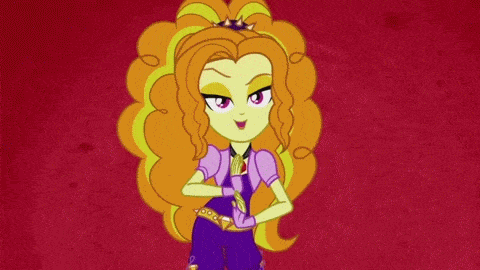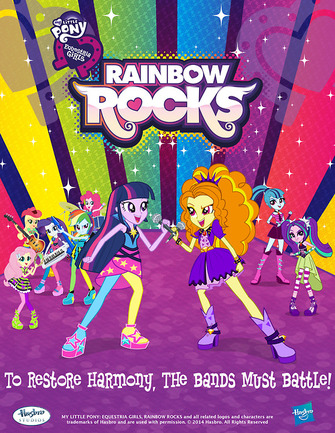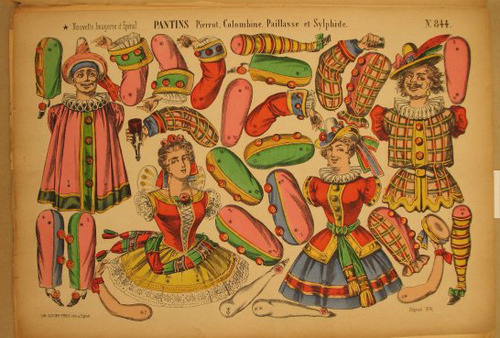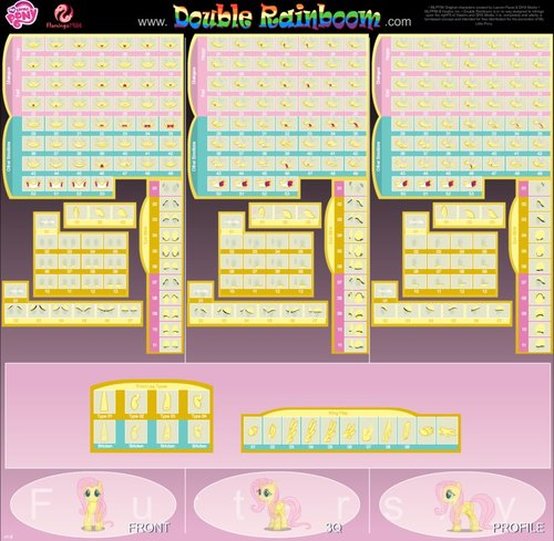Rainbow Rocks is a strange animal - a direct sequel to last Summer’s My Little Pony: Equestria Girls, (Thiessen, 2013), which was a spin-off of the ongoing animated series My Little Pony: Friendship is Magic (Various, 2010-Present), which was itself a reboot of the 1980’s cartoon My Little Pony (Bacal, 1986-1987), which was created for the express purpose of promoting the eponymous toy line. As one might imagine, an origin this convoluted makes any succinct overview of this movie’s plot rather tricky. Nevertheless, I shall persevere. Rainbow Rocks follows the trials of “The Rainbooms” a musical girl group who all attend the same high school. The band members all share a mysterious enchantment that imbues them with magical abilities whenever they play their instruments together. However, when their actions attract the attention of a trio of evil sirens who hope to usurp the powers of “The Rainbooms” ensorcelled Teeny Pop ballads, our protagonists are left with no choice but to openly fight this new menace at their school’s first ever battle of the bands.
From a narrative perspective, it would be incredibly easy to dismiss this movie as nothing more than a glorified seventy-five minute long toy commercial. However, that would be an unforgivable disservice to the animators at DHX Media and their subsidiary, Studio B Productions, who have consistently pushed the technical boundaries of Flash animation to its limit. Rainbow Rocks is no exception and currently stands at the high-water mark of that particular medium.
By Flash animation standards, Rainbow Rocks looks amazing. Its models present a virtually unparalleled level of fluidity and articulation, which makes viewing them a joy, regardless of the context. Couple this with the fact that the entire film was the result of less than one year’s production time, its crew’s accomplishments become all the more impressive. The average Dreamworks animated feature can take five times that long to produce.[i]
This unparalleled speed of production is due entirely to the unique properties of Flash animation. Unlike other forms of 2D animation, Flash does not require its character models to be manually drawn in every frame to create an illusion of movement. Thanks to its entirely digital nature, most Flash character models are actually comprised of a series of interchangeable pieces that when layered on top of one another appear to create a seamless whole. Each of these pieces is mounted on an invisible point of articulation, which allows that specific component to be rotated a full three hundred and sixty degrees around that position. These articulation points are connected to one another, creating a sort of skeleton, or “rig,” that provides the entire structure for a Flash model. Think of it as being like a digitized Pantin mechanical paper doll.
By now, one might wonder why such an automated, sterile form of animation is even deserving of any attention. And to answer that, I need to go back about 15 years to the dawn of the internet. You see, Flash was originally designed as a program capable of efficiently streaming full-length cartoons over the internet, while still remaining well below the 1MB threshold which was about all early computers could manage.[ii] Flash largely achieved this by utilizing the same tricks it does today: recycling assets, swapping rig components in lieu of animating actual transitions, and reading files as a series of movements instead thousands of individual images.
The difference is that in the early aughts, Flash was still only capable of reliably streaming extremely basic, choppy animations, like Badgers. (Picking, 2003)

Whereas today, well, we have Rainbow Rocks.

So, is Rainbow Rocks a good movie? I would argue that yes it is. Despite the fact that its overall premise makes viewing it unrelentingly prohibitive to anyone unfamiliar with its source material, Rainbow Rocks remains a competent, clever, film that creatively makes the absolute most of its resources. And regardless of medium, or context, I believe that is worthy of real praise.
[i] http://www.dreamworksanimation.com/insidedwa/productionprocess
[ii] https://www.adobe.com/macromedia/events/john_gay/page04.html




 RSS Feed
RSS Feed
